Browse Exhibits (21 total)
Identity through Illinois Music Education
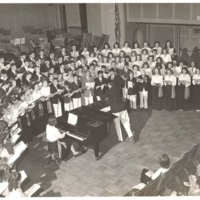
In America c. 1800, music making was beginning to be recognised as an ability which nearly all humans had the ability to partake in. Some American religious scholars even saw it as a duty, essential to the worship of God. In 1838, Lowell Mason, a leading composer in American hymnal tunes, persuaded the Boston School Committee to include music education as a curricular subject. This was one of the key steps toward wide-spread music education as is common in America today.
Post WWI, music education shifted its focus to American patriotism. In this new era, teaching methods began to be standardized. Educators came up with various number or solfege systems to teach their students melody.
An increase in music literacy and general literacy encouraged the rise of independent schools and businesses to create mail-order music education catalogs, which allowed interested parties to self-teach, or use in standardized classes similar to what we are familiar with now.
Now, in the 21st c. era of music making, many people still bond through music. American culture has changed, but music education still often reflects the values of patriotism, and group identity building. Social connections flourish through the simple love of music, and often, adolescent identification with musical artists or groups serves the desire to fit in and be accepted.
Ensembles provide a place where young students are able to find and develop their individuality while being a part of a community. According to Elizabeth Cassidy Parker, a music education researcher who has been teaching and writing in the field for 25 years, “Related studies in school music and community choral ensembles have focused on belonging, meaning, motivation, and ensemble singing as providing therapeutic benefit.”
Further studies have shown that identity development often starts with the decision to get involved in music whether that is choir, band, or musicals. William Dabback, music ed. Ph.D. says that, “Music allows for the structure, expectations, and an avenue for members to express identity.” Through those experiences with music, adolescents grow and find identities which follow them into adulthood.
Through the collection of these items, we can see the effects of music education on students in Illinois. These artifacts are what remain of the happy memories, and community building which went on in the Illinois education system. Our featured items span from 1942-2018, and are from several different institutions, but they carry similar meanings as part of their owners identities. We have mainly compiled artifacts from students' high school experiences, as that is when many adolescents begin to develop autonomy, and choose the groups they wish to identify with.
Education Outside the Classroom: Silenced History
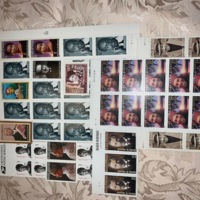
The way history has been taught over time has changed, different stories have recieved more time in the spottlight while others are overlooked. A smany individuals see personal history discarded highlighting what is learned outside the classroom is importanty as it can oftentimes be more impactful than what is traditionally taught. Featuring a few of these items, the stories they tell, and impact they made will show the importance of silenced education.
Apparel in American Education
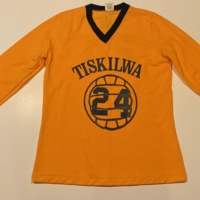
These items tell a story. It is that of the elite status symbol becoming a memento of childhood and bonds. It is that of a celebration of self within a larger educational community. Unlike tokens that signify merely a group experience, these items, be it by number, jewel, or size, are crafted to the individual experience of a student. These pieces are present at some of life’s greatest achievements, they become a part of the person who wears them. The decor is meant to signify the identity and how the individual wishes to be viewed. Some of these important items, not too unlike wedding gowns, family pocket watches, and wedding rings, have significance in being passed down. They hold a part of the person with them. Education represents, for some, a simpler time in our history. For others, it is a time of progression and personal growth. These items are more than metal and cloth; they are memories, and they are tapestries of our lives that we carry on ourselves.
In this exhibit, we preserve something stronger than an artifact; we preserve a memory. Here, within databases and code, lies something warmer: a human experience. Now immortalized, these stories will continue to reach students who will continue to dance, to share, and to lead their own victories. This exhibit also speaks to the memories of those lucky enough to already possess them.
Subconscious disposition is embodied in our way of dress and the items that we choose to express ourselves. As we have grown in methods of thought and practice, ornamentation has changed to adhere to new traditions. Certain items do not carry, as they are formed and then realized as a kind of hindrance. We do not wear family crests, but the name of our family and of ourselves can fit on a hand. We cannot wear all sports gear at all times to display our belonging and communal spirit; we have condensed it to jackets and jerseys on our backs. We cannot drape ourselves elaborately in all things that have meaning. That is why these condensed items mean so much; they bear the weight of all the memories we cannot hold on our persons. We long for ways to evolve ourselves physically, and with the items in education, we are allowed to form the identity of our own choosing within a time of decision. We celebrate that time, that connectedness, and the ability to paint oneself with the effects of education. It exists beyond the classroom and halls to dance studios and football fields. It’s on our fingers, our feet, and our shoulders: education has truly left its mark on us.
The Summer of Forward Thinking
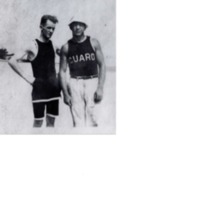
The Notre Dame Football program is nothing shy of a historic program, making strides to change the game and change with the game. Perhaps it could be argued that Notre Dame Football made the biggest contribution to the game that football has ever seen. Notre Dame Football legends, Knute Rockne and Gus Dorais spent the summer of 1913 in Sandusky, Ohio. Here they spent their time at Cedar Point as life guards. In their free time they worked endlessly to perfect the forward pass. At this time the forward pass was scarcely used in football but by the end of the summer, Notre Dame Football had every intention to change the game.
WWI Pamphlets
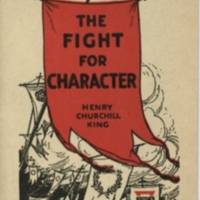
Founded in 1844 the Young Men’s Christian Association (YMCA) sought to provide refuge and respite for young men during Europe’s Industrial Revolution. (1) The organization built up steam over time with new branches popping up all over the globe. This exhibit contains booklets that were published by the American YMCA and sent to young American soldiers fighting overseas during World War I. These booklets were meant to inform, entertain, and keep soldiers on the moral path while they were away from home. While most were published for the YMCA this collection also contains literature published by the U.S. Chaplain and advertising companies such as those for toothpaste brand Kolynos.
Since its founding, the YMCA has sought to provide asylum for young men. The mission of the organization did not change even when the world was at war. The YMCA sought to strengthen the minds, bodies, and faith of the young men fighting for the Allied powers. The booklets featured in this exhibit were part of their efforts to provide entertainment, recreation, and rest for soldiers in order to boost morale in a moral manner. They were also meant to provide spiritual support to the men who encountered combat. The YMCA wanted to encourage young American soldiers to hold onto their faith in spite of all the horrors they would experience during their time fighting overseas. The booklets displayed in this virtual exhibit were provided by Tom Wright after having purchased them from the John Powers Estate Auction in Jacksonville, IL in 2020.
1. “1800-1899,” Our History, The YMCA, 2022, accessed October 28, 2022, https://www.ymca.org/who-we-are/our-history/founding-years.
The Souvenir: Memories of Travel
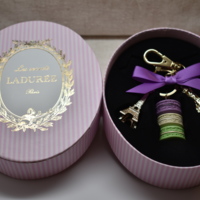
The souvenir. The trinkets people buy as a memento for themselves or others on their travels. These are the objects we buy to remind us of a particular time, place, person, or moment we wish to remember. It is tangible evidence of our experiences.
Tourists’ expenditures for shopping account for 30% to 33 % of their total travel spending (1). Whether people buy magnets, antiques, bracelets, or household goods on their travels, people are compelled to bring something back with them. Remembering the stories over time is difficult, but it is the feel, smell, and touch of things that trigger a memory.
Memory is the encounter “between the embodied human being and the inanimate thing that occasions the act of remembrance” (2). Physical objects can protect the memories of important events, such as vacations, and memories of people. Souvenirs act as a facilitator of memory. Sitting on shelves or in drawers, the souvenirs people buy become the vehicles of time travel, helping us relive memories of places, events, feelings, and people we have experienced.
Explore the memories of visitors to our harvest from the travels they took though time.
1. Litirell, M. A., Baizerman, S., Kean, R., Gahring, S., Niemeyer, S., Reilly, R., & Stout, J. "Souvenirs and Tourism Styles." Journal of Travel Research 33, no. 1 (1994): 3–11, https://doi.org/10.1177/004728759403300101.
2. László Munteán, Liedeke Plate, and Anneke Smelik. "Things to Remember," in Materializing Memory in Art and Popular Culture, ed. László Munteán, Liedeke Plate, and Anneke Smelik, (New York: Routledge, 2017), 2.
Coal Mining and Identity
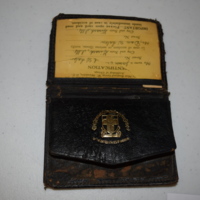
Coal mining was once the burning heart of the Illinois economy. However, since after the Second World War, the coal mining industry in Illinois has been in decline. Where once there were thousands of mines in operation, now there are dozens. Despite its reduced economic relevance for the state, the culture of coal mining lingers in the lives and memories of Illinois residents. More than just an occupation, coal mining touched every aspect of life from religion, to social class, to individual and community identity.
This exhibit uses items from the 2024 History Harvest to tell the stories of coal miners here in Illinois, focusing heavily on how occupations create shared bonds of identity. Each item has something to say about the history of coal in Illinois and abroad, as industry connected the world, coal, one of its main fuels, connected people. A United Mine Workers Union card from 1898 offers an example of the convergence of organized labor and coal mining in communities that were often marginalized based on ethnicity. A coal miner’s leather wallet from 1918 filled with Catholic memorabilia indicates the degree to which coal mining and religious affiliation were intertwined. Two figurines made from Welsh coal connected miners across an ocean due to a shared identity and profession. The miner’s award box from Peabody Energy showed how miners celebrated their own when they were able to retire, and the gifts they chose to commemorate this occasion. The pipe from a long gone church organ shows the importance of faith and community to immigrant miners. The Mother Jones dinner program shows the impact of a national figure who forever impacted unions and the coal mining industry across the united states.
Pins and Patches
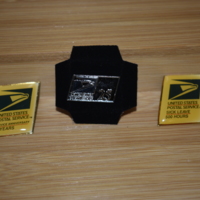
Over the course of history, personal identification and visual recognition have been crucial in social interactions. Pins, badges, name tags, patches, and other items that display a message are a significant part of material culture and have been for a long time. In the workplace specifically, all of these types of items are essential to relationships and communication. An employee name tag aids customers in identifying who is available for help or assistance. Pins can be given by an employer to an employee for outstanding service, length of employment, or for a special achievement. For example, former Secretary of State Madeline Albright is well known for her use of pins and brooches to send a political message to her opponents or allies. Albright would often wear animal shaped brooches depending on their associated meaning. When she was deemed a “serpent” by Saddam Hussein, she immediately appeared on stage wearing a snake pin to show that she was not afraid of such comments.[1] Like Albright, many have used pins, buttons, patches, and other related paraphernalia to display values or positions. These items can hold incredible meaning or be used simply to identify oneself; there is a wide range of utilization.
This exhibit aims to highlight items from our 2024 collections that fall under the categories of “pins and patches” or anything similar. These items represent an array of uses, meanings, and personal importance. From a Sheriff’s Department ID badge to a set of pins earned for service with the United States Postal Service, this unique set of featured items will present the various purposes for them in the lives of local Illinoisans.
[1] Newsweek. “Madeleine Albright on the Pins She Wore”. Updated March 13, 2010. https://www.newsweek.com/madeleine-albright-pins-she-wore-79187
Innovations in Customer Service
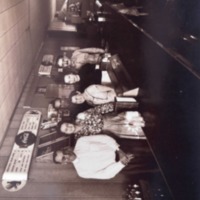
Businesses in the customer service industry have consistently evolved with the changing times to better exhibit corporate policy, technological shifts, and customer engagement. These innovations can be seen in the type of businesses that open and close according to supply and demand, the different equipment businesses use, and the change in the ways that products are produced and promoted to the public. However, it is curious to discover what explicitly sparks a change in policy, prompting innovation and change materialistically in stores and restaurants. As technology shifts, what components of everyday life in customer service fade away during this process?
This exhibit includes items that exemplify some of these changes and the different motives businesses had for creating innovation in their customer service design. From a local cafe in Southern Illinois to a country-wide movie theater chain, these items will answer the question as to what it is that encourages businesses to innovate their customer service initiatives.
Integration into the Workplace
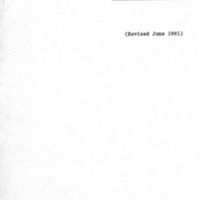
It is necessary for jobs to integrate their employees into the workplace, its rules and regulations, and its culture. Depending on a job and its requirements, there are a variety of ways—some more involved than others—in which workers can become accustomed to or a part of workplace practices. Recording such methods in an archive allows for the recognition of the diversity of these practices and how they have shifted over time.
This collection represents papers and documentation that welcome and orientate individuals to the workforce. Included in this collection are orientation documents that establish the Andersen Consulting dress code in the 1990s. This dress code details the standards of appearance and dress for women working for Andersen Consulting. Next is a stock (share) of ownership in the Boston Celtics from the late 1980s. This stock was available for purchase in the gift shop of the Boston Garden, and is a true share of ownership for the Celtics. Third is a license given to an individual to welcome them to the Aiken County Sheriff's Department. This particular license is for the Detention Division of the Aiken County Sheriff’s Department, which covers Aiken’s detention center. The fourth and final item in this collection is a program for the inauguration of the Illinois Senate from January 2023. This program lists all the Senators of the 103rd Illinois General Assembly.
References:
Basketball Reference. “Boston Celtics Franchise Index.” Accessed November 7th, 2024. https://www.basketball-reference.com/teams/BOS/.
Charles Schwab. “What Are Stocks.” Accessed November 8th, 2024. https://www.schwab.com/stocks/understand-stocks.
Keck, Patrick M. “State legislators sworn in, 103rd Illinois General Assembly begins.”The State Journal Register (Springfield, IL), Jan 12, 2023. https://www.sj-r.com/story/news/politics/state/2023/01/12/state-legislators-sworn-in-103rd-illinois-general-assembly-begins/69798849007/.
Lang, Robert M. “The Hidden Dress Code Dilemma.” The Clearing House 59, no. 6 (1986): 277–79. http://www.jstor.org/stable/30186540.
